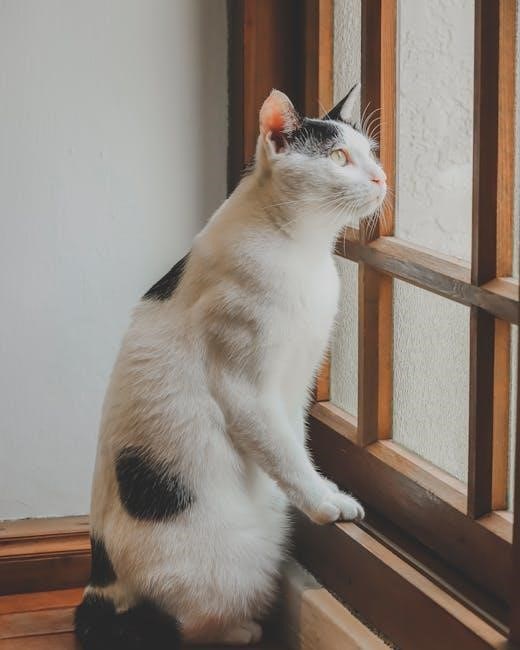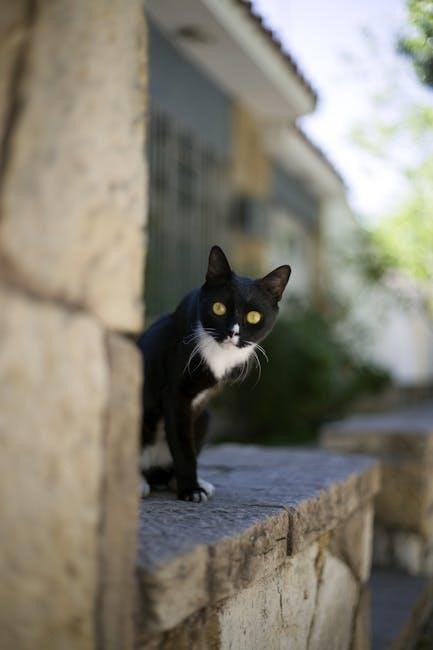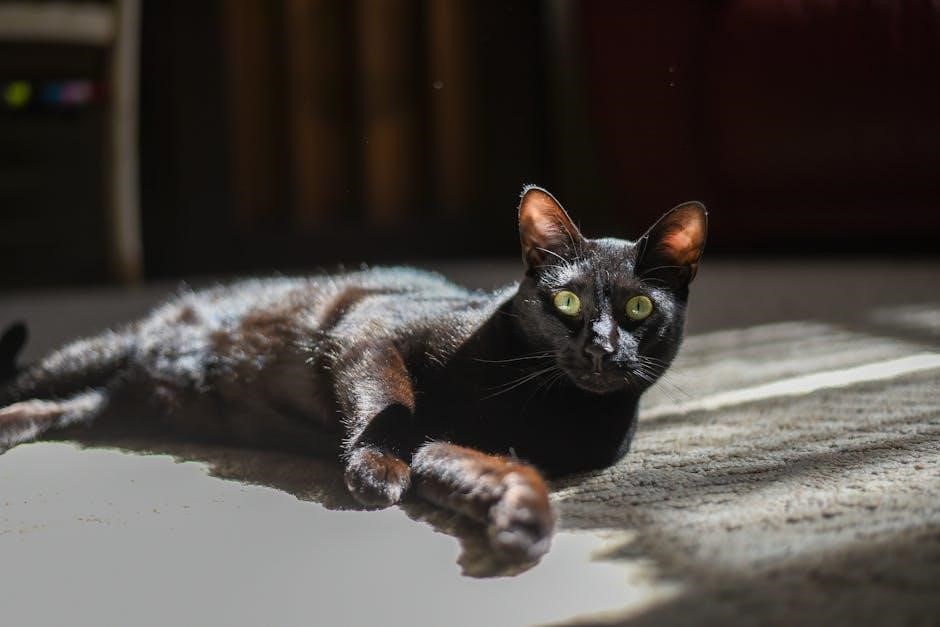Edgar Allan Poe’s “The Black Cat” is a chilling tale of guilt, madness, and supernatural revenge, available as a free PDF download from various sources.
Overview of the Story and Its Significance
Edgar Allan Poe’s “The Black Cat” is a masterful tale of horror and psychological complexity, exploring themes of guilt, madness, and supernatural revenge. The story follows a narrator whose descent into alcoholism leads to brutal acts against his beloved black cat, Pluto, and ultimately to tragic consequences. Through its dark and haunting narrative, Poe delves into the depths of human depravity and the unsettling power of conscience. The story’s significance lies in its ability to provoke both fear and introspection, making it one of Poe’s most enduring works. Available as a free PDF download, “The Black Cat” remains a timeless classic in Gothic literature, continuing to captivate readers with its chilling exploration of the human psyche.

Publication and Historical Context
First published in The Saturday Evening Post in 1843, “The Black Cat” by Edgar Allan Poe is a public domain story, freely available as a PDF.
First Publication in The Saturday Evening Post (1843)
Edgar Allan Poe’s “The Black Cat” first appeared in The Saturday Evening Post on August 19, 1843. This publication marked the story’s debut, captivating readers with its dark themes and psychological depth. The tale was later widely circulated, contributing to Poe’s reputation as a master of Gothic literature. Today, the story remains in the public domain and is freely available as a PDF, allowing readers to easily access and appreciate this classic work. Its enduring popularity is evident through numerous adaptations and its inclusion in various digital formats for modern audiences to enjoy.

Plot Summary of “The Black Cat”
The story follows a narrator’s descent into madness, detailing his cruel treatment of his black cat, Pluto, and the subsequent haunting by a mysterious second cat.
The Narrator and His Relationship with Pluto
The narrator initially shares a deep bond with Pluto, his black cat, whom he lovingly cares for. Pluto is described as a beautiful, unusually large black cat named by the narrator. The cat is a cherished companion, following the narrator everywhere and being his sole responsibility. However, as the narrator’s alcoholism worsens, his affection turns to cruelty, leading to tragic consequences. Pluto’s unwavering loyalty contrasts sharply with the narrator’s deteriorating character, highlighting the themes of betrayal and moral decay. Their relationship serves as a catalyst for the dark events that unfold in the story.
The Tragic Downfall and the Hanging of Pluto
The narrator’s alcoholism leads to a violent outburst, resulting in Pluto’s tragic hanging. One morning, in a fit of drunken rage, the narrator ties a noose around Pluto’s neck and hangs the cat from a tree. This horrifying act marks a turning point in the narrator’s descent into madness. Pluto’s death is a senseless tragedy, driven by the narrator’s inability to control his darker impulses. The event sets off a chain of eerie and supernatural events, further entangling the narrator in guilt and horror. The hanging of Pluto symbolizes the narrator’s complete moral collapse and serves as a pivotal moment in the story’s dark progression.
The Psychological Deterioration of the Narrator
The narrator’s mental state declines rapidly due to alcoholism, leading to irrational violence and cruelty, ultimately driving him to commit horrifying acts against Pluto and his wife.
The Role of Alcoholism in His Actions
The narrator’s descent into madness is deeply intertwined with his struggle with alcoholism. His addiction fuels irrational behavior, leading to violent outbursts and cruel decisions. As his drinking escalates, so does his abuse of Pluto, culminating in the cat’s tragic hanging. Alcoholism clouds his judgment, eroding his moral boundaries and amplifying his darker impulses. The story vividly illustrates how addiction can destroy empathy and reason, driving individuals to commit horrifying acts. The narrator’s alcoholism not only destroys his relationship with Pluto but also sets the stage for the eventual murder of his wife, highlighting the destructive power of unchecked addiction. This theme serves as a stark warning about the dangers of alcoholism and its consequences on human behavior.

The Supernatural Elements in the Story
The story features supernatural elements, notably the mysterious appearance of a second black cat, which haunts the narrator and symbolizes guilt and revenge.
The Appearance of the Second Black Cat
The second black cat’s appearance is a chilling and supernatural event that haunts the narrator. After Pluto’s brutal death, a mysterious black cat appears, eerily similar to Pluto, with a rope around its neck. This cat’s presence symbolizes guilt and revenge, tormenting the narrator psychologically. Its constant appearance and ominous behavior escalate the story’s horror, leading to the tragic discovery of the wife’s decomposing body with the cat perched on her head. The cat’s shape is even seen outlined on the bedroom wall, heightening the supernatural dread. This element underscores the themes of guilt, madness, and the inescapable consequences of evil actions.
Symbols and Themes in “The Black Cat”
The black cat symbolizes guilt, revenge, and the supernatural, while the rope around its neck represents the narrator’s inescapable remorse and descending madness.
The Symbolism of the Black Cat Itself
The black cat, Pluto, symbolizes both innocence and the narrator’s guilt, representing the duality of human nature. Initially, Pluto is a beloved pet, embodying purity and companionship. However, as the narrator’s psyche deteriorates, the cat becomes a target of his cruelty, symbolizing the destruction of innocence. The black cat’s second appearance, with a rope around its neck, haunts the narrator, serving as a reminder of his irreversible sins. This duality underscores Poe’s exploration of the human psyche, where darkness and madness emerge from within, intertwined with the supernatural. The cat’s presence ultimately embodies the narrator’s conscience, tormenting him with the consequences of his actions, and highlighting the inescapable nature of guilt. This symbolism is central to the story’s themes of moral decay and psychological horror.
The Significance of the Rope Around the Cat’s Neck
The rope around the black cat’s neck is a haunting symbol of the narrator’s violent past and his irreversible descent into madness. When the cat reappears with the same rope, it serves as a chilling reminder of the narrator’s brutal act of hanging Pluto. This eerie detail ties the crime to its consequences, emphasizing the inescapable nature of guilt. The rope symbolizes the narrator’s attempt to control and dominate, while its reappearance signifies the futility of such efforts. It also foreshadows the discovery of his wife’s body, linking the cat’s revenge to the ultimate unraveling of the narrator’s sanity. The rope becomes a visual motif of his moral and psychological downfall, reinforcing the story’s themes of guilt, retribution, and the supernatural.

The Tragic Ending and Moral Lessons
The story concludes with the horrific discovery of the wife’s body, alongside the vengeful cat, emphasizing the devastating consequences of cruelty and guilt, teaching moral accountability.
The Discovery of the Wife’s Body and the Cat’s Revenge
The story reaches its horrifying climax when the narrator and the police discover his wife’s decomposing body in the cellar, with the black cat perched on her head. The cat, described as having one glowing eye and a blood-red mouth, appears to exact revenge for Pluto’s murder. This chilling scene underscores the narrator’s descent into madness and guilt, as the cat’s presence symbolizes the inescapability of his crimes. The discovery shocks the officers, who immediately realize the narrator’s culpability. This moment highlights the moral lesson that cruelty and violence lead to devastating consequences, while the cat serves as a haunting symbol of retribution and the supernatural forces at play.
